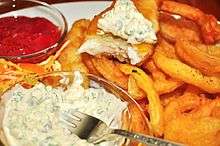Tartar sauce
 Tartar sauce is often served with fried seafood. | |
| Alternative names | Tartare |
|---|---|
| Type | Sauce |
| Place of origin | Europe |
| Main ingredients | Mayonnaise, capers, gherkins, lemon juice and tarragon |
|
| |
Tartar sauce (in the UK, New Zealand and Australia, tartare sauce) is a mayonnaise or aioli-based sauce, typically of a rough consistency. It is often used as a condiment with seafood dishes.[1]
Composition
Tartar sauce is based on either mayonnaise (egg yolk, mustard or vinegar, oil) or aioli (egg yolk, olive oil, garlic, lemon juice), with certain other ingredients added. In the UK, recipes typically add to the base capers, gherkins, lemon juice, and dill. US recipes may include chopped pickles or prepared green sweet relish, capers, onions (or chives), and fresh parsley.[1] Chopped hard-boiled eggs or olives are sometimes added, as may be Dijon mustard and cocktail onions.[2] Paul Bocuse describes sauce tartare explicitly[3] as a sauce remoulade,[4] in which the characterising anchovy purée is to be substituted by some hot Dijon mustard.
History and etymology
The sauce and its name have been found in cookbooks since the 19th century. The name derives from the French sauce tartare, named after the Tatars (Ancient spelling in French of the ethnic group: Tartare) from the Eurasian Steppe, who once occupied Ukraine and parts of Russia.[5]
Although it is unlikely that the Tatars ever made or consumed Tartar sauce, the actual origin of the sauce is indeed found East of France, which may have inspired the confusing name. In Turkey and the Levant, a condiment known as tarator has traditionally been used as a condiment to fried sea food. Turkish and Levantine tarator is usually a sauce based on tahini, not mayonnaise or aioli, but in regards to being a creamy, tangy accompaniment to fried fish and/or seafood, it is extremely similar to tartar sauce. The fact that tartar sauce made its first appearance in Western European cuisine in the mid 1800s coincides with a period of Orientalism (during which various aspects of Middle Eastern culture were glorified and absorbed by Western European cultures) lending credence to the idea that tartar sauce was adopted by France from the Arabic world.
See also
References
- 1 2 Isabella Graham Duffield Stewart; Mary B. Duffield (1878). The Home messenger book of tested receipts. Detroit: E. B. Smith & Co. p. 31. Retrieved 2 June 2012.
- ↑ Louisette Bertholle; Julia Child; Simone Beck (2001). Mastering the Art of French Cooking. 1. New York: Alfred A. Knopf. ISBN 978-0-307-95817-4. Retrieved 2 June 2012.
- ↑ Paul Bocuse, La cuisine du marché, 1976
- ↑ Bocuse describes the Remoulade just previous Sauce Tartare as a standard mayonnaise (egg yolks, vinegar, oil) with additional chopped capers, gherkins and herbs and some anchovy purée
- ↑ "tartar". Online Etymology Dictionary. Douglas Harper. 2001–2002. Retrieved 2 June 2012.
External links
| Wikimedia Commons has media related to Tartar sauce. |
- An explanation of the name's origin, from The Straight Dope
- Tartar sauce and steak
- A definition at Allrecipes.com
